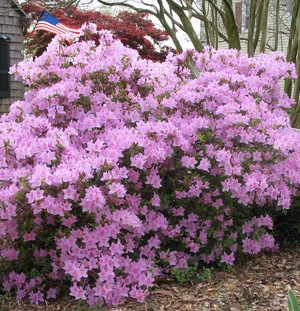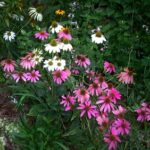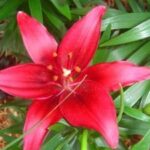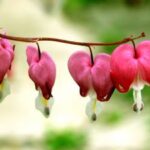When you hear the words “shade garden”, the image conjured up is probably all green plants, like ferns, hosta, or even coleus. There’s nothing wrong with ferns and hosta and in fact, they make the perfect starting point for a shade garden. To add punches of colors, use flowers that will bloom in partial or even full shade.
When choosing the flowers, consider its mature height and when it blooms to provide the most impact in your flower bed. Be sure to check hardiness zones for plants best suited for your area. Note: The lowest zone number is 1, meaning at that location the minimum temperature expected is minus 50 degrees. The highest zone number is 11, where the minimum temperature is 40 degrees. See the USDA hardiness zone map for details.
Bulbs and Tubers
Bulbs and tubers get planted in the fall and bloom in the spring. Once planted, you only need to dig and divide them every few years. Following are flowers stemming from bulbs or tubers that work fine in shaded areas.
Hardy Cyclamen. According to Ed Hume of HumeSeeds.com, this flower blooms “during the autumn months of September, October and November. A few species flower earlier and others into the months of January and February.” Flowers can be pink or white. Grows to five inches. Zones 5-8.
Spanish Bluebells. Tiny little bell-shaped flowers in either lavender-blue, lavender-pink, or white, this beauty does well cut for a floral arrangement. It blooms midspring after growing about a foot tall. Zones 4-10.
Spring Snowflake. This delicate white flower grows to about six inches and blooms in late spring. Each petal of the blossom is marked with a tiny dot. Zones 4-8.
Winter Aconite. Reaching just four inches in height, these yellow beauties will pop up in late winter. Zones 4-7.
Flowering shrubs can be used to fill areas where you have a lot of space. Just remember when planting shrubs to space them apart according to the directions that come with the shrub. You want to ensure they have plenty of room to expand as they grow. Following are some flowering shrubs.
Azalea. (Click picture next to article title) Very popular and easy to grow, common azalea are available in white, shades of pink, coral, and some varieties come in lavender. In the spring, they offer a flood of color as they bloom. According to Azaleas.org, “Some varieties can get quite tall, into the tens of feet, while others remain spreading groundcovers less than 12 inches in height.” Zones 7-9.
Carolina Allspice. The Carolina allspice can grow up to 9 feet tall and 12 feet wide. You will need to prune it to keep it a reasonable size. Purchase the plant when it is in bloom so you can smell the flowers to ensure you are buying a sweet scented bush since not all Carolina allspice carry a pleasant fragrance. Zones 4-9.
Summersweet. This bush presents with fragrant pink flowers that attract butterflies, bees, and humming birds. The 2-6 spikes of flowers last about four weeks, starting in late summer. Zones 3-9.
There are many flowers that thrive in partial to full shade. Please note that this listing is not all inclusive but instead lists popular plants.
Begonia. Depending on the variety, begonia can grow 12-24 inches. The plant has waxy leaves and it produces tiny pink, white or red flowers in mid-summer. Zones 6-11.
Impatiens. (Click picture next to article title) According to Yardener, impatiens “rank among the top ten most popular annuals in the United States.” Reaching heights of less than a foot the blossoms almost completely hide the leaves. You can choose from pink, red, coral, and white. Zones 3-11.
Blue Torenia. Reaching 6-12 inches, this plant continues to bloom with small purplish-blue flowers all summer, attracting humming birds. Spreading about 12 inches, torenia makes a great border. In warmer climates, torenia may reappear each year much like a perennial. Zones 3-11.
Following are some perennial flowering plants covering many zones.
Astilbe. (Click picture next to article title) This plant, which can reach up to three feet, self seeds easily. Each spring you will find at least one new starter plant nearby. The “flowers” of the astilbe are feather-like; one variety is even called “Ostrich Plume.” Colors choices are pink, red, and white. As the color fades, the plume changes to shades of brown where it continues to enhance the landscape. Zones 4-8.
Barrenwort. The leaves of the barrenwort give this plant a dense appearance. When the flowers bloom, they look like clusters of tiny yellow flowers sprinkled over a green leafy bush-like plant. This slow spreading plant reaches a height of about a foot. Zones 4-8.
Foam Flower. Foam flower gets its names from the appearance of the white or pink plumes of flowers that display in spring and early summer. This plant reaches a height of one foot. Zones 4-8.
Jack Frost Brunnera. This bush-like plant has very large leaves. The small blossoms that come out in the spring are five perfectly symmetric petals that are light blue charmers with a creamy center. Can reach up to 18 inches tall. Zones 3-7.
Lily of the Valley. Lily of the Valley has long leaves and the most fragrant white bell shaped blossoms in early spring. Word of caution – this plant can become invasion. Still, between the precious little flowers and the fragrance, it’s a winner. Plant in an area surrounded by a walkway to not only contain it, but to provide those strolling by with its delightful fragrance. Grows to six to eight inches. Zones 2-7.
Lungwort. The green leaves of the lungwort appear to be drizzled with light green, making them quite eye-catching. Its flowers bloom in late winter and can be pink, white or blue, reaching a height of 18 inches. Zones 5-8.
Spotted Deadnettle. This low growing plant (6-8 inches) has chartreuse colored leaves . The blossoms can be pink, white, or magenta. This plant grows fast, making it an excellent ground cover. Zones 4-8.
__________________
This article contains multiple pictures to the left of the article title. To view the pictures, place your mouse pointer in the upper left corner of the picture. When your pointer changes to a crosshair, click your mouse. You can then click the number box to look at additional pictures.
Resources:
USDA
DavesGarden.com
Yardner






